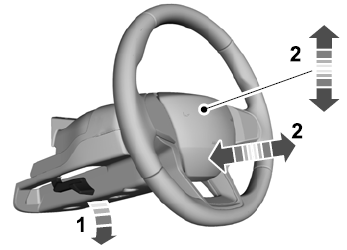Lincoln Aviator 2020-2025 Service Manual / Body and Paint / Body and Paint / Instrument Panel and Console / Removal and Installation - Auxiliary Power Point
Lincoln Aviator: Instrument Panel and Console / Removal and Installation - Auxiliary Power Point
Special Tool(s) / General Equipment
.jpg) |
501-194 Remover, Power Point TKIT-2014D-ROW2 TKIT-2014D-FL_ROW |
Removal
-
Open the power point cover.
.jpg) |
-
Position the power point extractor so that it engages in the adjacent slots in the power point socket.
Remove Suggested Tool: 501-194 Remover, Power Point.
.jpg) |
-
-
Install the receiver cup.
-
Install and tighten the wing nut.
Remove Suggested Tool: 501-194 Remover, Power Point.
-
Install the receiver cup.
.jpg) |
-
Tighten the wing nut to pull the power point socket out of the retainer.
Remove Suggested Tool: 501-194 Remover, Power Point.
.jpg) |
-
Disconnect the electrical connector.
.jpg) |
Installation
-
Connect the electrical connector and push the new power point socket into the retainer.
 Removal and Installation - Floor Console
Removal and Installation - Floor Console
Special Tool(s) /
General Equipment
Interior Trim Remover
Removal
NOTE:
Removal steps in this procedure may contain installation details...
Other information:
Lincoln Aviator 2020-2025 Owners Manual: Rear Parking Aid
WARNING: The system may not detect objects with surfaces that absorb reflection. Always drive with due care and attention. Failure to take care may result in a crash. WARNING: The system may not detect small or moving objects, particularly those close to the ground...
Lincoln Aviator 2020-2025 Service Manual: Removal and Installation - Rear Subframe
Special Tool(s) / General Equipment 300-OTC1585AEPowertrain Lift Vehicle/Axle Stands Wooden Block Removal NOTICE: Suspension fasteners are critical parts that affect the performance of vital components and systems. Failure of these fasteners may result in major service expense...
Categories
- Manuals Home
- Lincoln Aviator Owners Manual
- Lincoln Aviator Service Manual
- Anti-Theft Alarm
- Body and Paint
- Description and Operation - Jacking and Lifting
- New on site
- Most important about car
Adjusting the Steering Wheel - Vehicles With: Manual Adjustable Steering Column
WARNING: Do not adjust the steering wheel when your vehicle is moving.
Note: Make sure that you are sitting in the correct position.
Unlock the steering column. Adjust the steering wheel to the desired position.
Copyright © 2025 www.liaviator2.com

